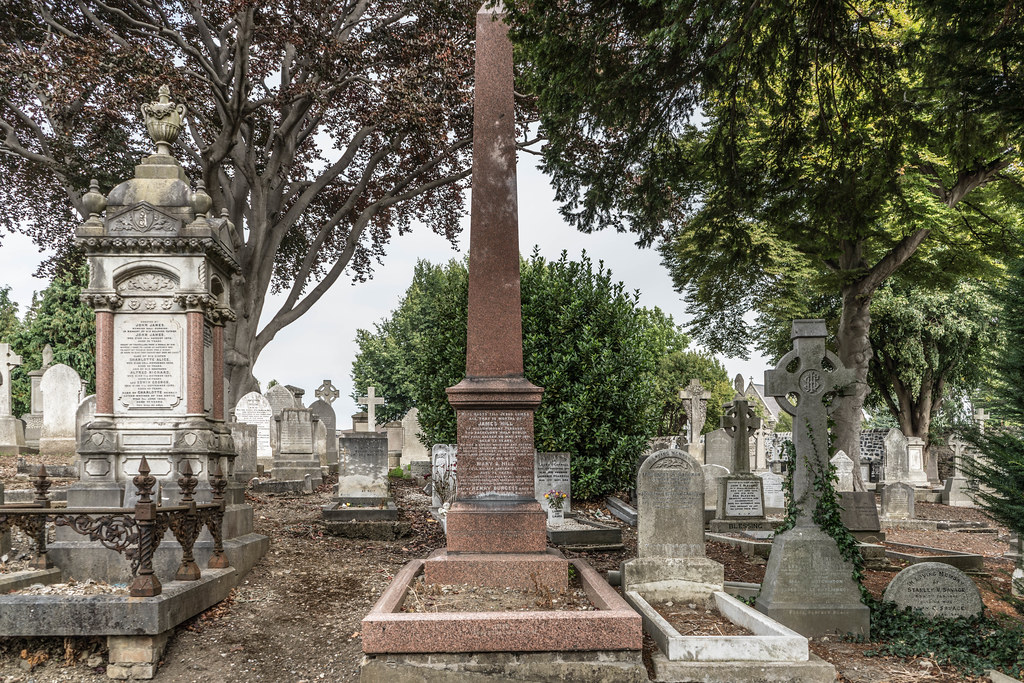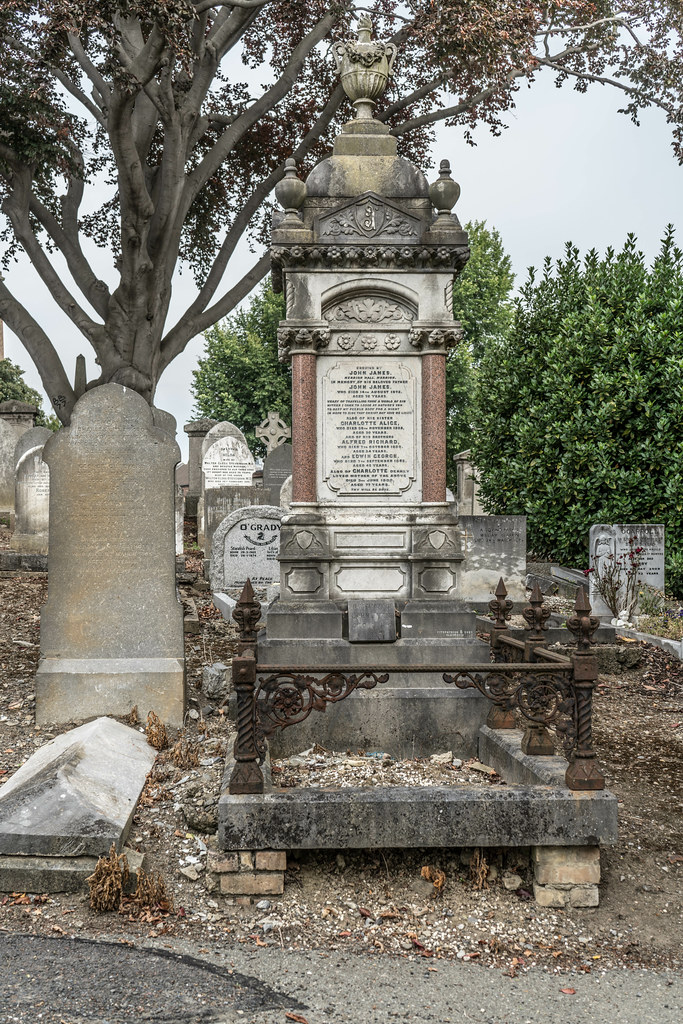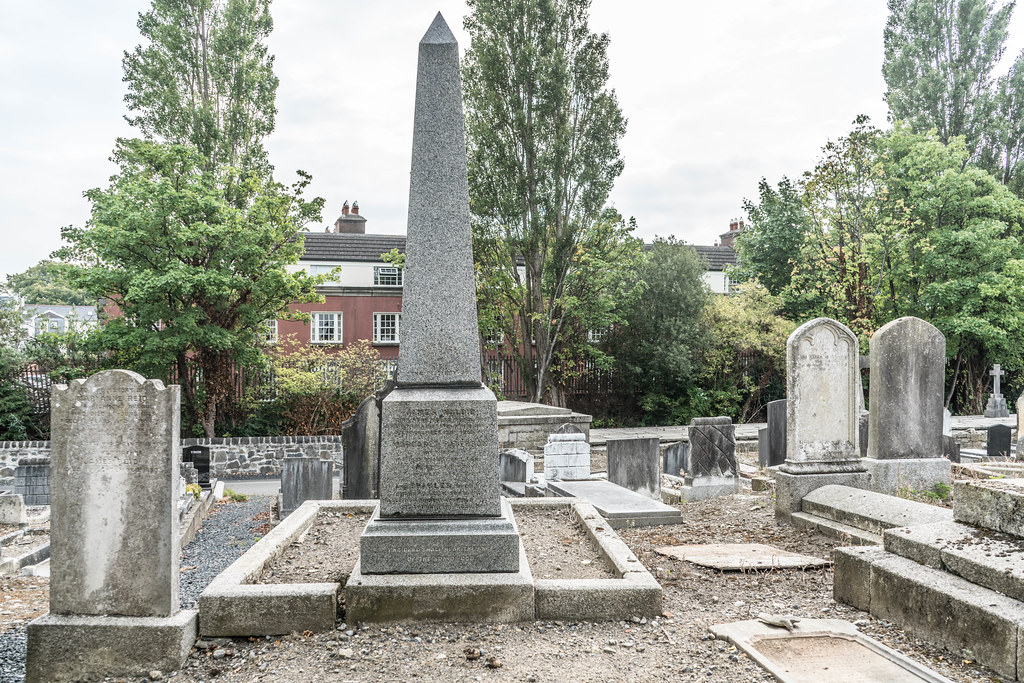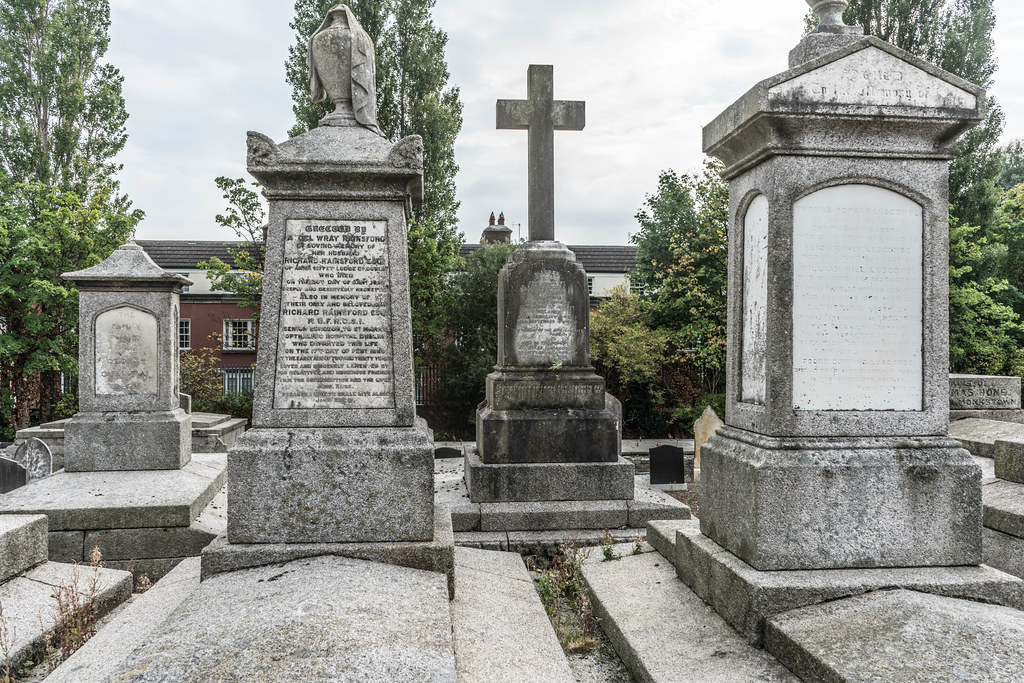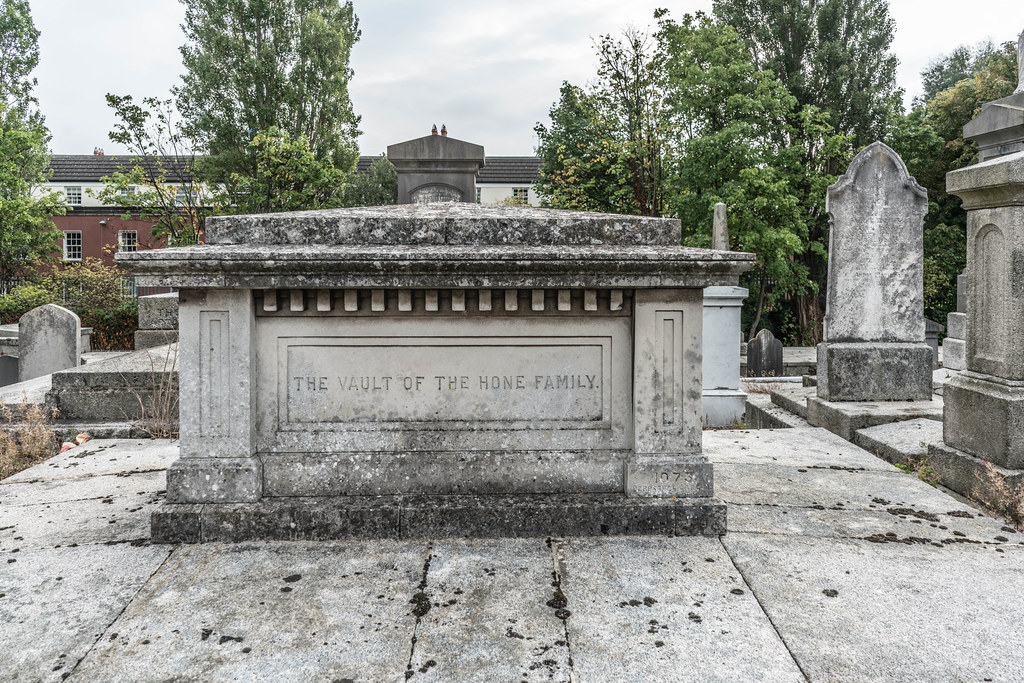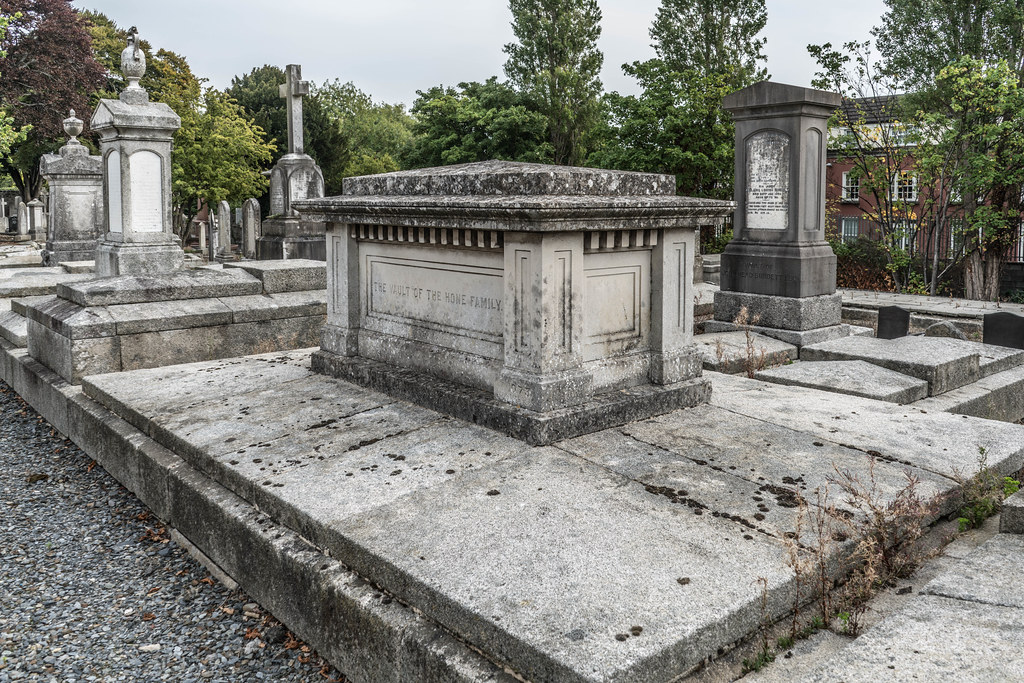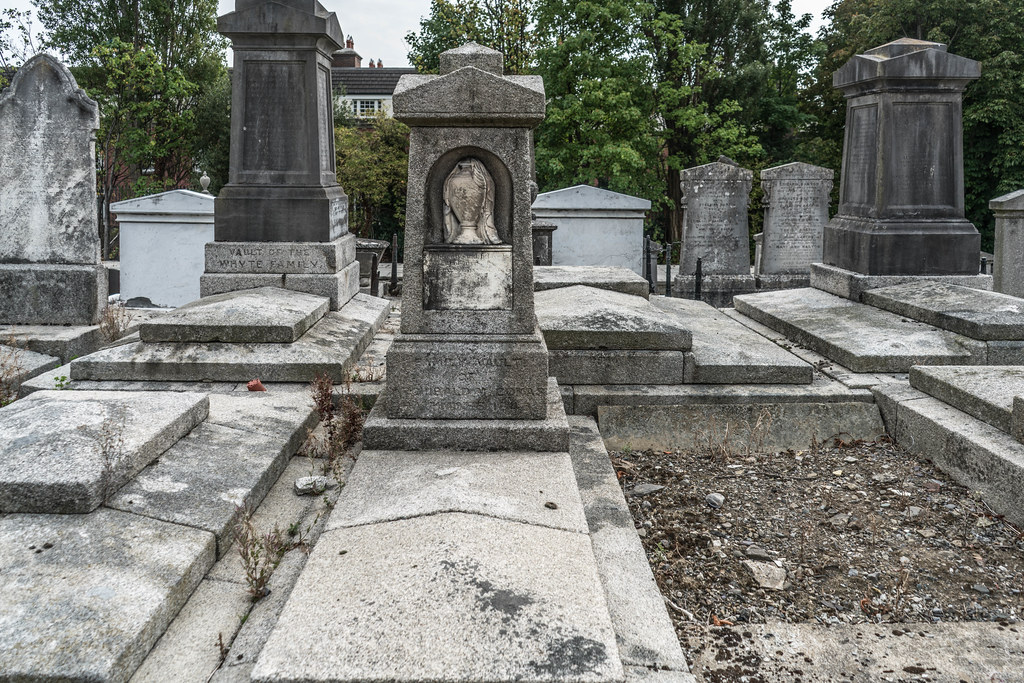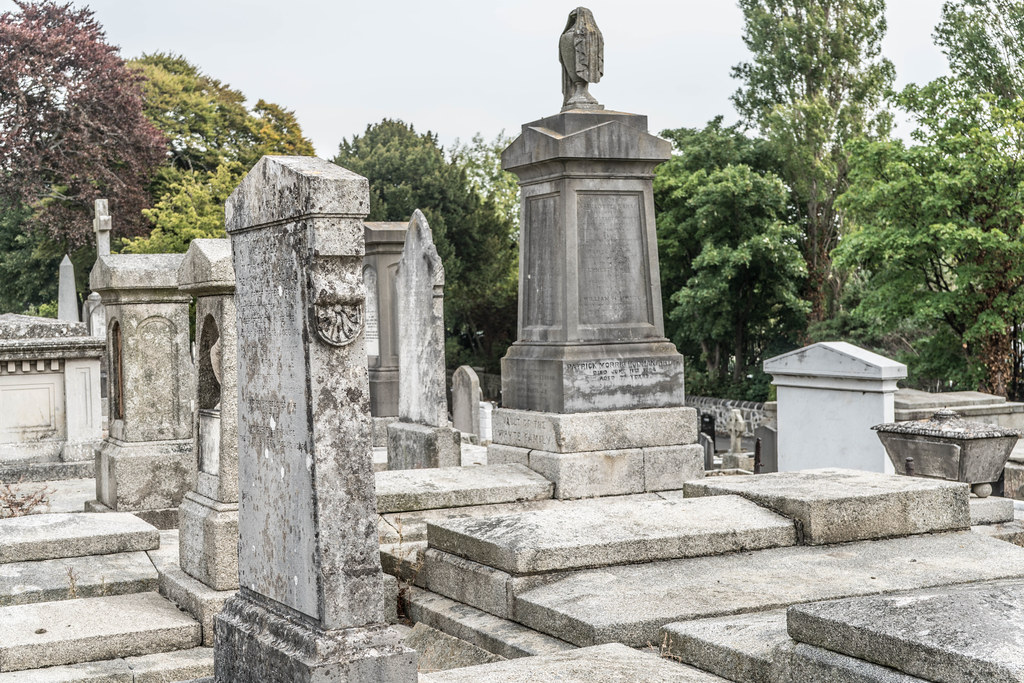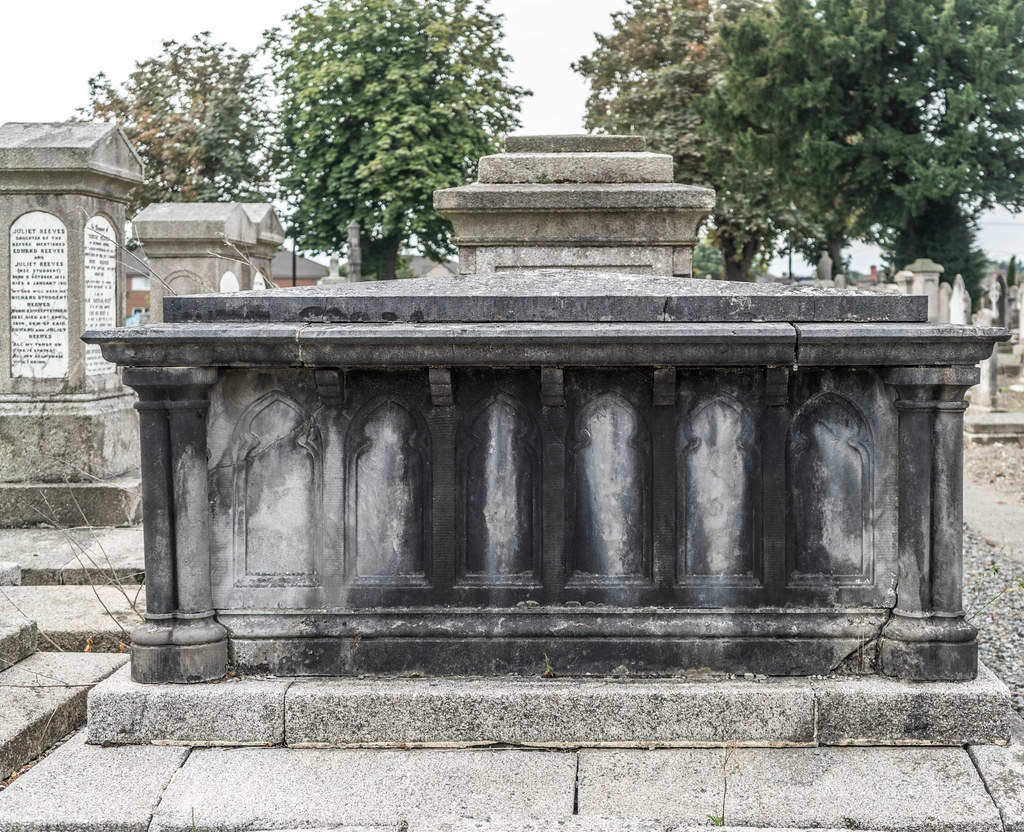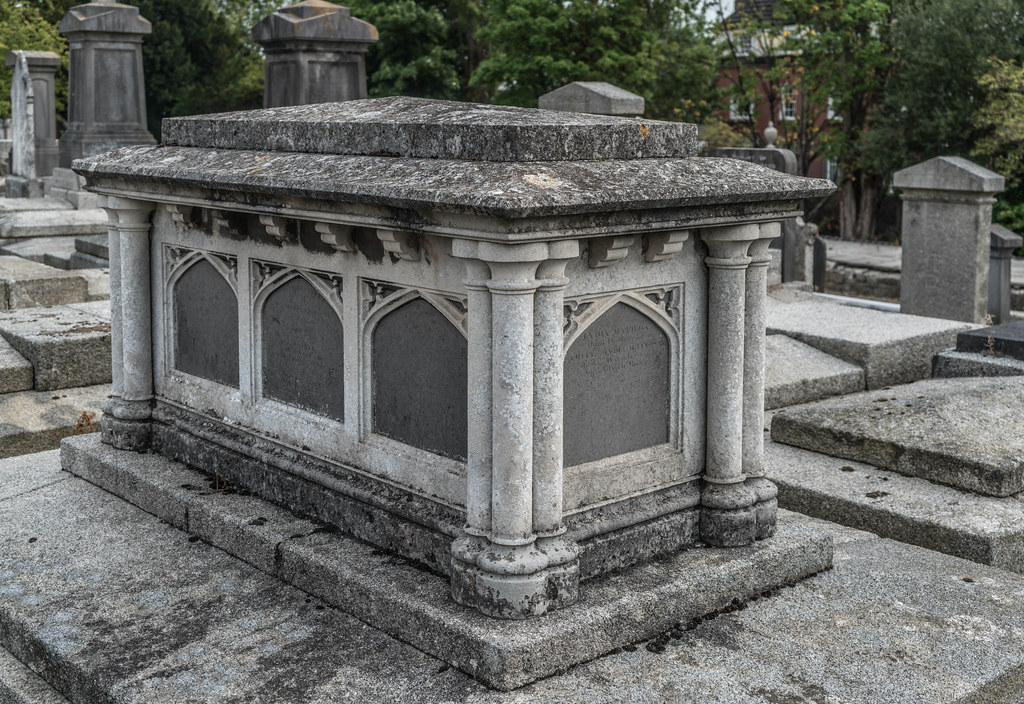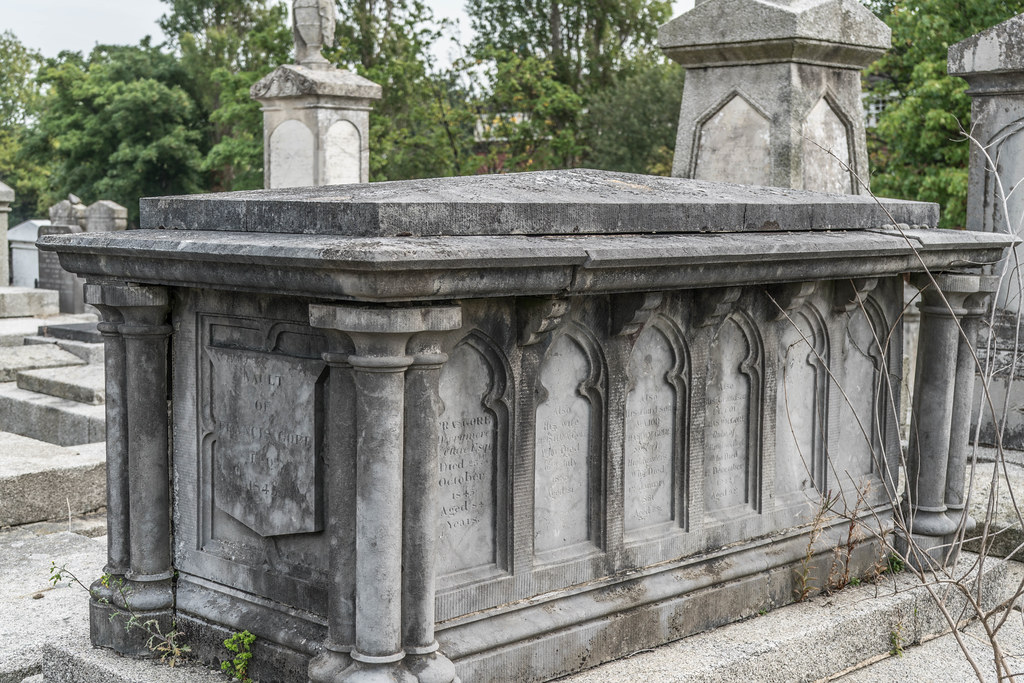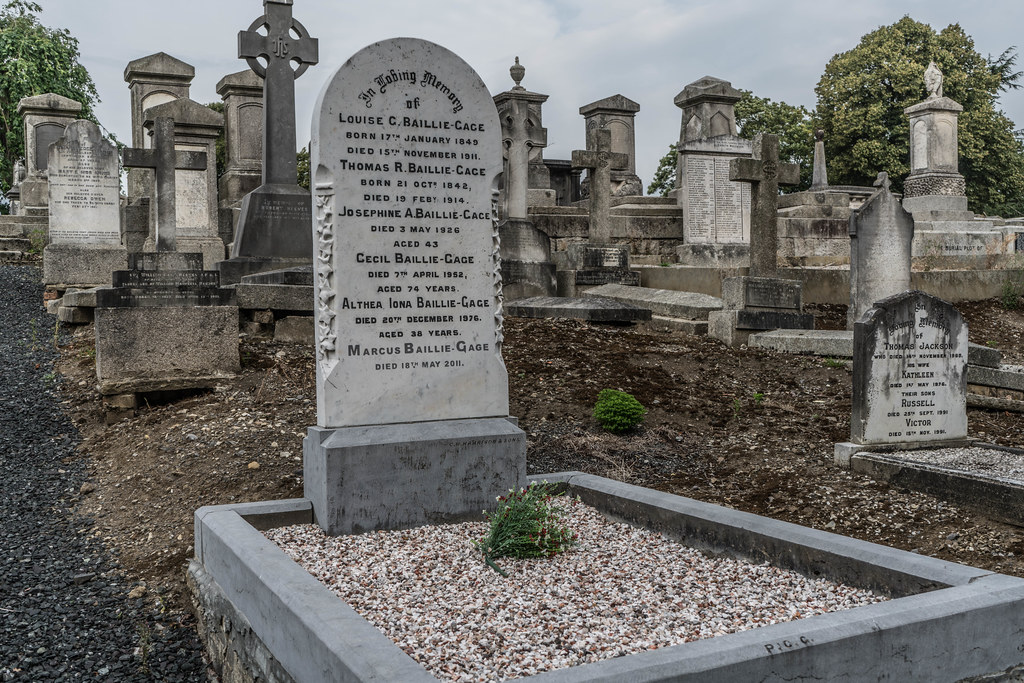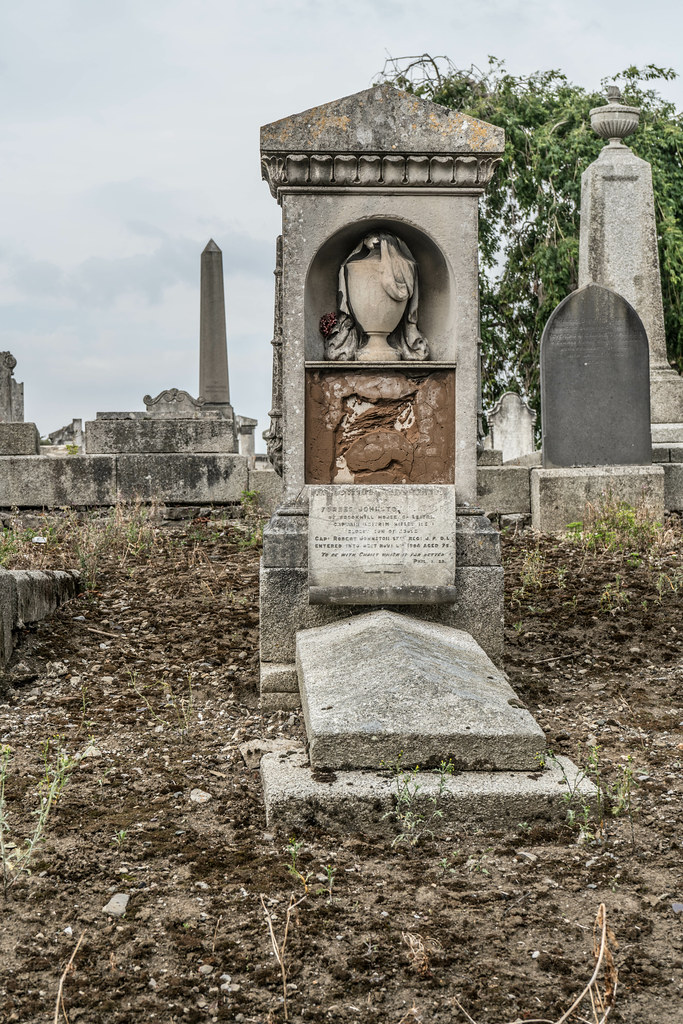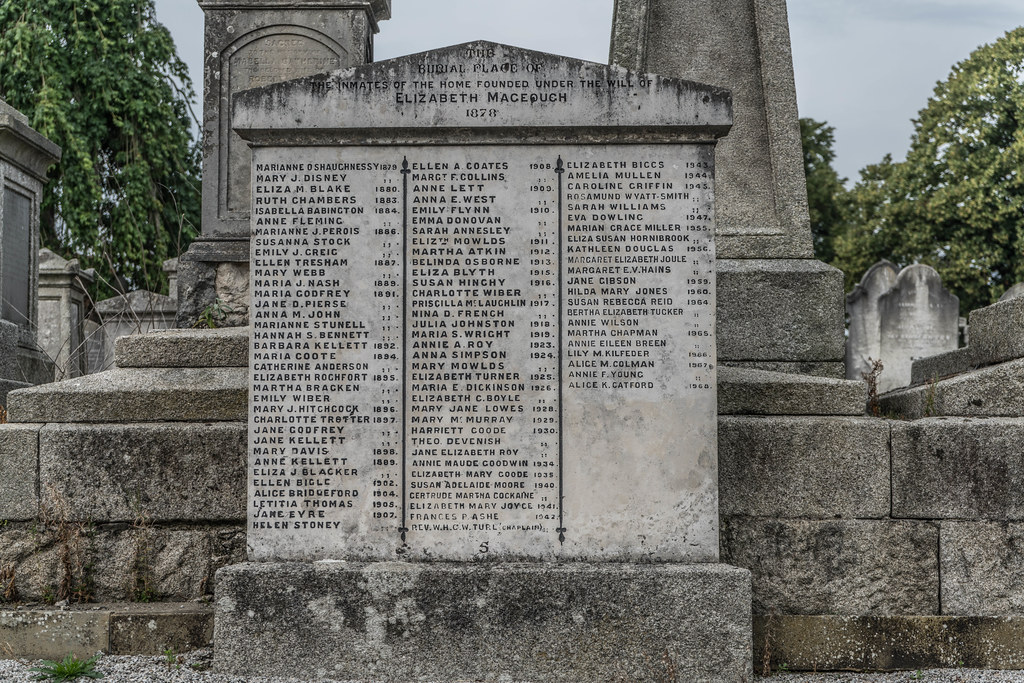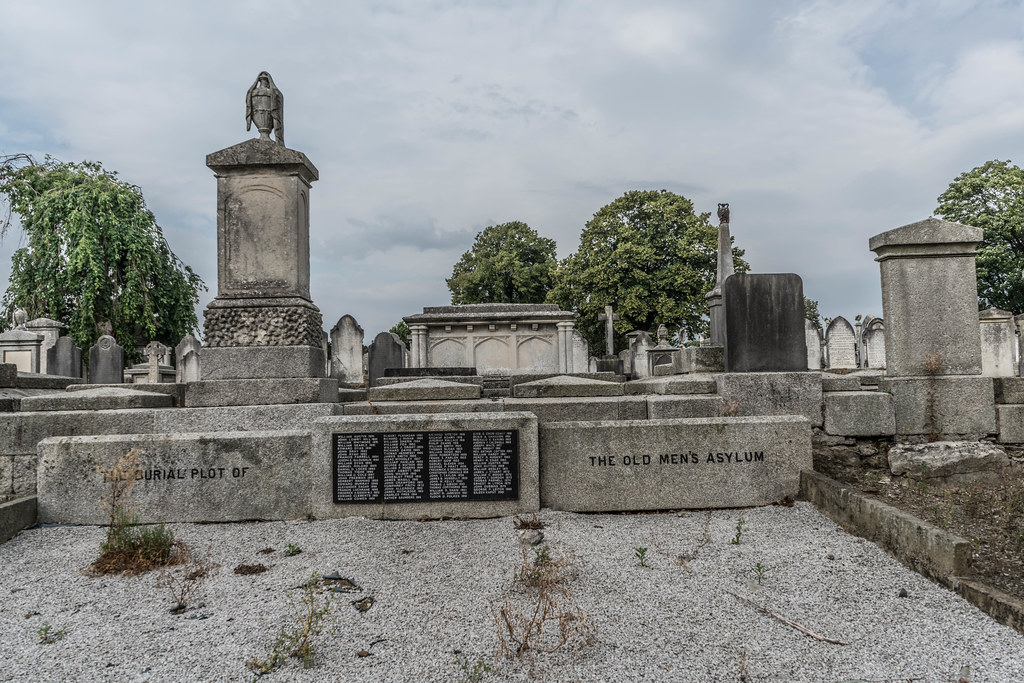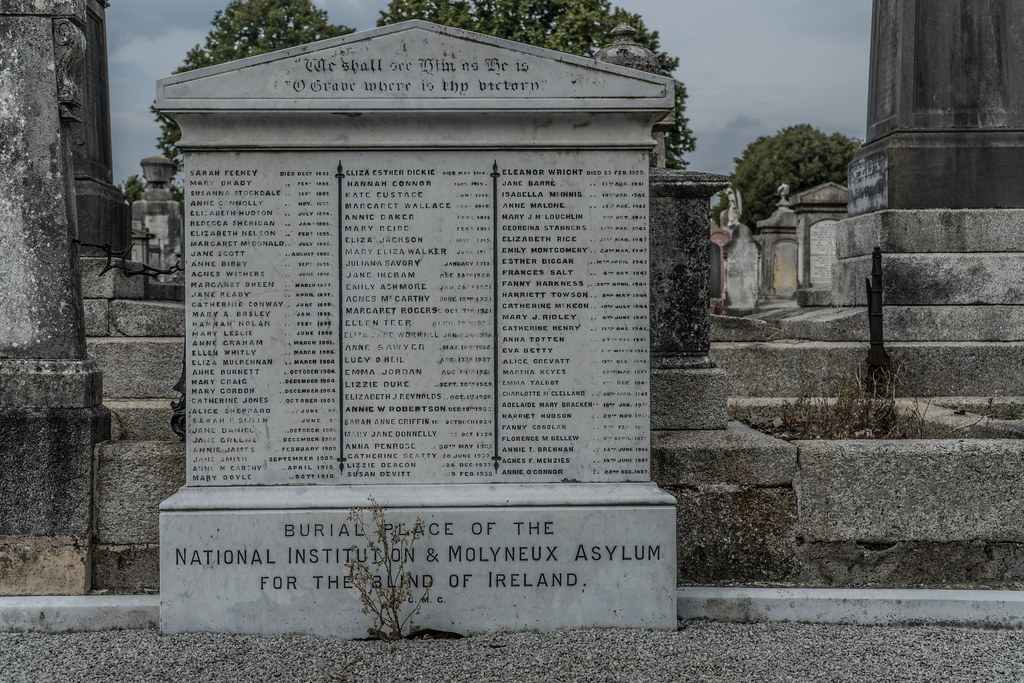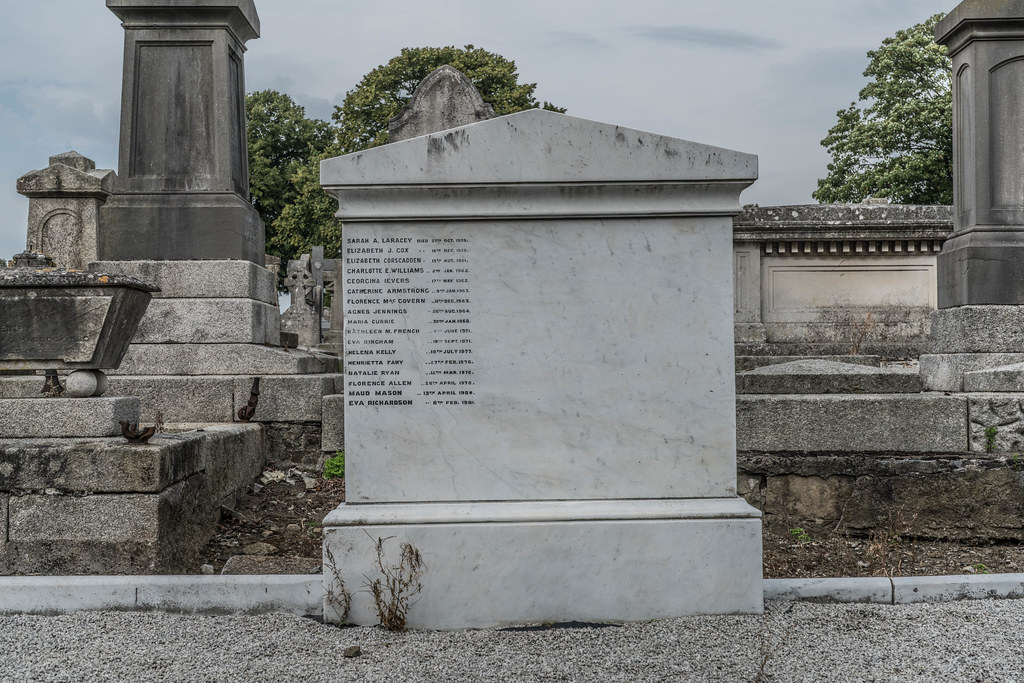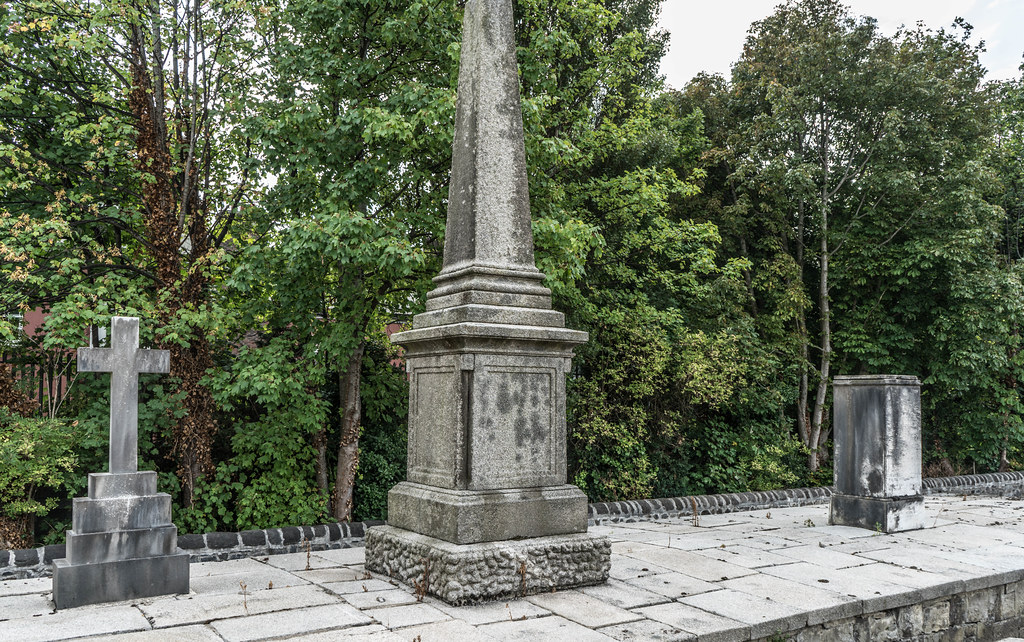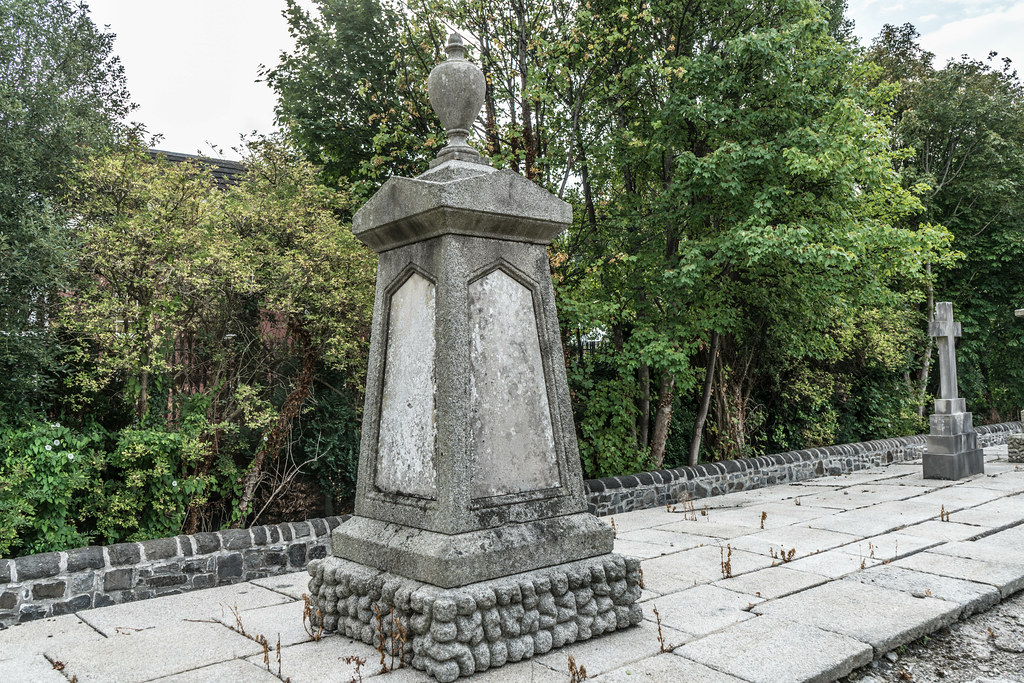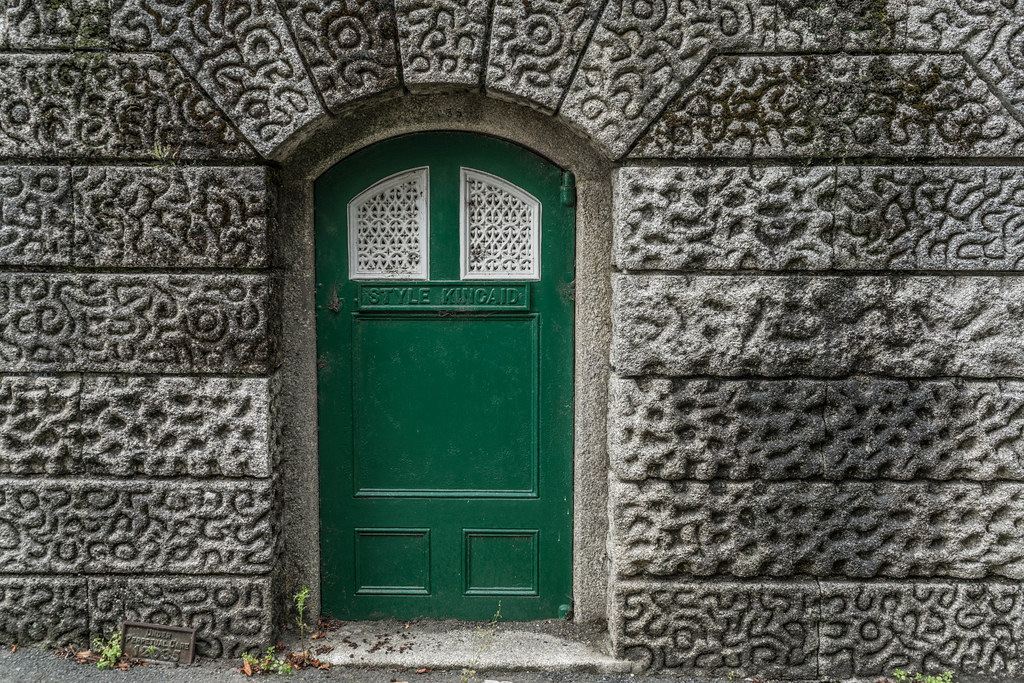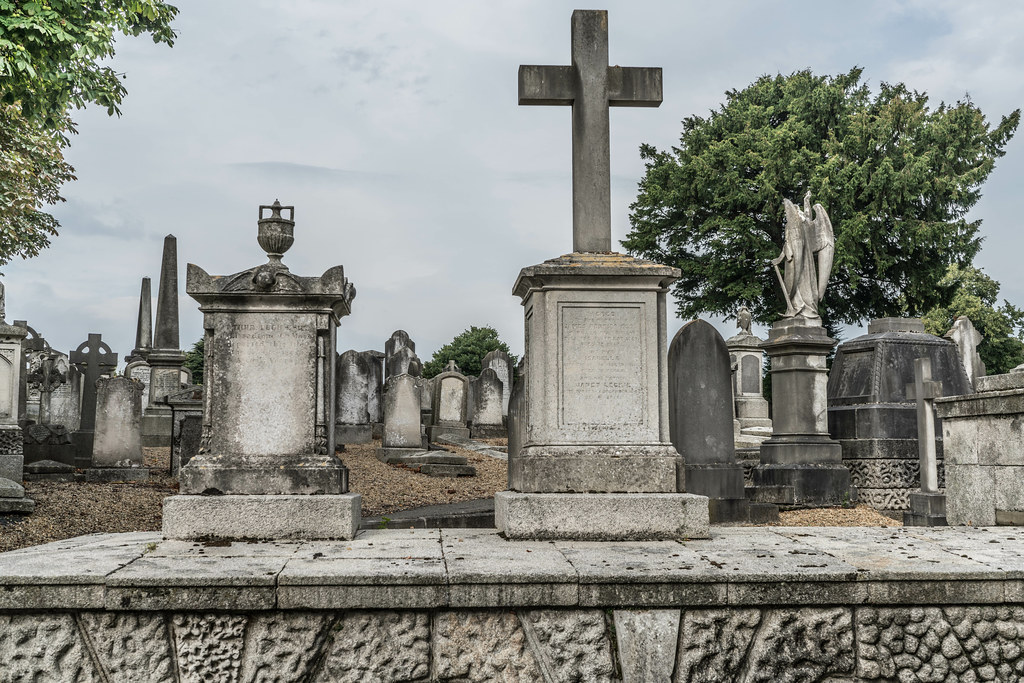
Custom Search
THE GREEN MENU OPTIONS ARE MOBILE FRIENDLY AND ARE FASTER SO THEY ARE RECOMMENDED. THE RED MENU OPTIONS ARE SOMEWHAT SLOWER DEPENDING ON YOUR DEVICE OR BROWSER AND ARE MORE SUITABLE FOR DESKTOPS AND LAPTOPS. THE BLUE OPTIONS ARE PAGE LINKS AND WILL BE PHASED OUT GOING FORWARD
MOUNT JEROME
Mount Jerome Cemetery & Crematorium is situated in Harold's Cross on the south side of Dublin. Since its foundation in 1836, it has witnessed over 300,000 burials. Mount Jerome was established as a non-denominational cemetery but effectively it was an exclusively Protestant cemetery until the 1920s.
I am familiar with the Cemetery as I lived beside it's outer wall for two years (1981/82) and two of my grandparents are buried there. After my grandmother's funeral because the place was really depressing a very old uncle of mine described the graveyard as "an excellent advertisement for cremation" (back then Irish Catholics did not consider cremation an option). It is therefore somewhat ironic that as the result of the opening of a Crematorium in 2000 revenues have recovered and the Cemetery has undergone a reversal of fortune.
Due to the declining burial numbers in the 1970's, the condition of the Cemetery began to deteriorate as revenues fell. In 1984 it was put into voluntary liquidation. By the late 1990's, it had fallen into a serious state of neglect with large swaths of the cemetery covered in overgrowth. When I lived in the area the graves were often vandalised and at night a group of children would steal flowers from the graves in order to re-sell them the next day.
As already mentioned the cemetery was effectively reserved for protestants, especially wealthy ones, and as a result the place is a bit unusual. Many of those buried there were very wealthy and they wanted the world to know how important they had been when alive so they spent a fortune on elaborate memorials listing their virtues with very few references to religious matters or God. The one thing that struck me about the older sections of the cemetery is that there are very few crosses or truly christian symbols but here are many references to ancient Greece and Rome.
One striking feature is the large number columns that appear to be broken. Because the cemetery had been in very poor condition for an extended period I had assumed, when I first noticed them, that they were broken due to wear, general damage or vandalism. However, after further investigation I discovered that a broken column indicates a life cut short, a memorial to the death of someone who died young or in the prime of life, before reaching old age.
The notorious Martin Cahill (1949–1994) (known as "The General") is buried in Mount Jerome. His gravestone has been vandalised on numerous occasions and is currently broken in two with the top half missing. His body has since been removed to an unmarked grave elsewhere in the cemetery.
I am familiar with the Cemetery as I lived beside it's outer wall for two years (1981/82) and two of my grandparents are buried there. After my grandmother's funeral because the place was really depressing a very old uncle of mine described the graveyard as "an excellent advertisement for cremation" (back then Irish Catholics did not consider cremation an option). It is therefore somewhat ironic that as the result of the opening of a Crematorium in 2000 revenues have recovered and the Cemetery has undergone a reversal of fortune.
Due to the declining burial numbers in the 1970's, the condition of the Cemetery began to deteriorate as revenues fell. In 1984 it was put into voluntary liquidation. By the late 1990's, it had fallen into a serious state of neglect with large swaths of the cemetery covered in overgrowth. When I lived in the area the graves were often vandalised and at night a group of children would steal flowers from the graves in order to re-sell them the next day.
As already mentioned the cemetery was effectively reserved for protestants, especially wealthy ones, and as a result the place is a bit unusual. Many of those buried there were very wealthy and they wanted the world to know how important they had been when alive so they spent a fortune on elaborate memorials listing their virtues with very few references to religious matters or God. The one thing that struck me about the older sections of the cemetery is that there are very few crosses or truly christian symbols but here are many references to ancient Greece and Rome.
One striking feature is the large number columns that appear to be broken. Because the cemetery had been in very poor condition for an extended period I had assumed, when I first noticed them, that they were broken due to wear, general damage or vandalism. However, after further investigation I discovered that a broken column indicates a life cut short, a memorial to the death of someone who died young or in the prime of life, before reaching old age.
The notorious Martin Cahill (1949–1994) (known as "The General") is buried in Mount Jerome. His gravestone has been vandalised on numerous occasions and is currently broken in two with the top half missing. His body has since been removed to an unmarked grave elsewhere in the cemetery.
LOADING
Notable people buried here include:
Robert Adams (1791–1875), physician and professor of surgery
Maeve Binchy (1940–2012), author (cremated)
Edward Bunting (1773–1843), musician, music-collector
Frederick William Burton (1816–1900), painter and director of the National Gallery
Peter Caffrey (1949–2008), actor (cremated) (Ballykissangel)
Sir Charles Cameron (1830–1921), for 50 years head of the Public Health Department of Dublin Corporation, along with two of his sons, Charles J. and Ewen Henry
James Campbell, 1st Baron Glenavy (1851–1931), lawyer, politician and Lord Chancellor of Ireland
William Carleton (1794–1869), writer
Thomas Caulfield Irwin (1823–1892), poet, writer, scholar
Abraham Colles (1773–1843), surgeon, professor of medicine
John Augustus Conolly VC (1829–1888), soldier
Michael Colivet (1882–1955), Irish politician, Commandant of the Irish Volunteers for Limerick City, a founding member of the Irish Republic and, in later years, Chairman of the National Housing Board.
Paddy Daly (1888–1957), member of the IRA during the War of Independence and later Major-General in the Irish Army
Achilles Daunt (1832–1878), preacher and homilist
Thomas Davis, (1814–1845), journalist, politician, founder of The Nation newspaper
Thomas Drummond (1797–1840), surveyor, Under-Secretary for Ireland
James Fitzgerald (1899–1971), American painter
Ethel Kathleen French (née Moore, 1871–1891), artist and illustrator, first wife of Percy French. She died in childbirth with their first child.
Edward Gibson, 1st Baron Ashbourne (1837–1913), lawyer and Lord Chancellor of Ireland
Robert Graves (1796–1853), professor of medicine and writer
Sir Richard John Griffith (1784–1878), geologist, mining engineer, chairman of the Board of Works, author of Griffith's Valuation
Thomas Grubb (1800–1878), optician, telescope-maker
Benjamin Guinness (1798–1868), brewer, philanthropist, and other members of the Guinness family
George Halpin (Sr.) (1779–1854), civil engineer and lighthouse builder
William Rowan Hamilton (1805–1865), mathematician and astronomer
James Haughton (1795–1873), social reformer
John Kells Ingram (1823–1907), politician, scholar, poet ("The Memory of the Dead")
John Hewitt Jellett (1817–1888), Provost of Trinity College
John Edward Jones (1806–1862), civil engineer and sculptor
David Kelly (1929–2012), actor (cremated)
Joseph Robinson Kirk (1821–1894), sculptor, who also executed the figure over the memorial of his father, Thomas
Thomas Kirk (1781–1845), sculptor, who also designed the Butler mausoleum in this cemetery
John Mitchell Kemble, scholar
Joseph Sheridan Le Fanu (1814–1873), writer and editor, along with his wife, Susanna Bennett, her father and two brothers, in the same vault.
Thomas Hawkesworth Ledwich (1823–1858), surgeon and anatomist
Thomas Langlois Lefroy (1776–1869), politician and judge
Jan Lukasiewicz (1878–1956), Polish philosopher and logician
David Marcus (1924–2009), Irish Jewish writer, editor
Sir Henry Marsh (1770–1860), physician
William Fetherstone Montgomery (1797–1859), obstetrican
Hans Garrett Moore VC (1830–1889), soldier
Arthur Thomas Moore VC (1830–1912), soldier
Sir Richard Morrison (1767–1849), architect (Pro-Cathedral, Trinity College, etc.)
William Vitruvius Morrison (1794–1838), architect; son and partner of Richard Morrison.
John Skipton Mulvany (1813–1870), architect who also designed a number of monuments in this cemetery, including the Mahony monument and Perry and West vaults
Máirtín Ó Cadhain (1906–1970), Irish-language writer
Máirtín Ó Direáin, (1910–1988), Irish-language poet.
Walter Osborne (1859–1903), artist
Peter Marshall (died 1890), prominent member of the Masonic and Orange Orders
William McFadden Orr (1866–1934), mathematician
George Papworth (1781–1855), architect
Jacob Owen (1778–1870), architect and engineer to the Board of Works
Edward Arthur Henry Pakenham, 6th Earl of Longford (1902–1961) was an Irish peer, politician, and littérateur
George Petrie (1790–1886), artist, archaeologist, musician
William Plunket, 4th Baron Plunket (1828–1897), Archbishop of Dublin
Sarah Purser (1848–1943), artist
George Russell (1867–1935), writer, artist
Cecil Sheridan (1910–1980), comedian and actor
John Skelton (1924–2009), artist and illustrator.
Ellen Smyly (1815–1901) founder of the Smyly Homes.
Robert William Smith (1807–1873), pathologist
Bindon Blood Stoney (1828–1909), engineer.
John Millington Synge (1871–1909), playwright
Isaac Weld (1774–1856), topographical writer, explorer and artist.
William Wilde, father of Oscar Wilde. His wife, Jane Francesca Elgee, is commemorated on Sir William's monument, but she was buried in Kensal Green Cemetery in London.
S. Allen Windle (1828–1880), Chaplain of the Mariners' Church, Dún Laoghaire
Edward Perceval Wright (1834–1910), ophthalmic surgeon, botanist and zoologist
Jack Butler Yeats (1871–1957), artist
Robert Adams (1791–1875), physician and professor of surgery
Maeve Binchy (1940–2012), author (cremated)
Edward Bunting (1773–1843), musician, music-collector
Frederick William Burton (1816–1900), painter and director of the National Gallery
Peter Caffrey (1949–2008), actor (cremated) (Ballykissangel)
Sir Charles Cameron (1830–1921), for 50 years head of the Public Health Department of Dublin Corporation, along with two of his sons, Charles J. and Ewen Henry
James Campbell, 1st Baron Glenavy (1851–1931), lawyer, politician and Lord Chancellor of Ireland
William Carleton (1794–1869), writer
Thomas Caulfield Irwin (1823–1892), poet, writer, scholar
Abraham Colles (1773–1843), surgeon, professor of medicine
John Augustus Conolly VC (1829–1888), soldier
Michael Colivet (1882–1955), Irish politician, Commandant of the Irish Volunteers for Limerick City, a founding member of the Irish Republic and, in later years, Chairman of the National Housing Board.
Paddy Daly (1888–1957), member of the IRA during the War of Independence and later Major-General in the Irish Army
Achilles Daunt (1832–1878), preacher and homilist
Thomas Davis, (1814–1845), journalist, politician, founder of The Nation newspaper
Thomas Drummond (1797–1840), surveyor, Under-Secretary for Ireland
James Fitzgerald (1899–1971), American painter
Ethel Kathleen French (née Moore, 1871–1891), artist and illustrator, first wife of Percy French. She died in childbirth with their first child.
Edward Gibson, 1st Baron Ashbourne (1837–1913), lawyer and Lord Chancellor of Ireland
Robert Graves (1796–1853), professor of medicine and writer
Sir Richard John Griffith (1784–1878), geologist, mining engineer, chairman of the Board of Works, author of Griffith's Valuation
Thomas Grubb (1800–1878), optician, telescope-maker
Benjamin Guinness (1798–1868), brewer, philanthropist, and other members of the Guinness family
George Halpin (Sr.) (1779–1854), civil engineer and lighthouse builder
William Rowan Hamilton (1805–1865), mathematician and astronomer
James Haughton (1795–1873), social reformer
John Kells Ingram (1823–1907), politician, scholar, poet ("The Memory of the Dead")
John Hewitt Jellett (1817–1888), Provost of Trinity College
John Edward Jones (1806–1862), civil engineer and sculptor
David Kelly (1929–2012), actor (cremated)
Joseph Robinson Kirk (1821–1894), sculptor, who also executed the figure over the memorial of his father, Thomas
Thomas Kirk (1781–1845), sculptor, who also designed the Butler mausoleum in this cemetery
John Mitchell Kemble, scholar
Joseph Sheridan Le Fanu (1814–1873), writer and editor, along with his wife, Susanna Bennett, her father and two brothers, in the same vault.
Thomas Hawkesworth Ledwich (1823–1858), surgeon and anatomist
Thomas Langlois Lefroy (1776–1869), politician and judge
Jan Lukasiewicz (1878–1956), Polish philosopher and logician
David Marcus (1924–2009), Irish Jewish writer, editor
Sir Henry Marsh (1770–1860), physician
William Fetherstone Montgomery (1797–1859), obstetrican
Hans Garrett Moore VC (1830–1889), soldier
Arthur Thomas Moore VC (1830–1912), soldier
Sir Richard Morrison (1767–1849), architect (Pro-Cathedral, Trinity College, etc.)
William Vitruvius Morrison (1794–1838), architect; son and partner of Richard Morrison.
John Skipton Mulvany (1813–1870), architect who also designed a number of monuments in this cemetery, including the Mahony monument and Perry and West vaults
Máirtín Ó Cadhain (1906–1970), Irish-language writer
Máirtín Ó Direáin, (1910–1988), Irish-language poet.
Walter Osborne (1859–1903), artist
Peter Marshall (died 1890), prominent member of the Masonic and Orange Orders
William McFadden Orr (1866–1934), mathematician
George Papworth (1781–1855), architect
Jacob Owen (1778–1870), architect and engineer to the Board of Works
Edward Arthur Henry Pakenham, 6th Earl of Longford (1902–1961) was an Irish peer, politician, and littérateur
George Petrie (1790–1886), artist, archaeologist, musician
William Plunket, 4th Baron Plunket (1828–1897), Archbishop of Dublin
Sarah Purser (1848–1943), artist
George Russell (1867–1935), writer, artist
Cecil Sheridan (1910–1980), comedian and actor
John Skelton (1924–2009), artist and illustrator.
Ellen Smyly (1815–1901) founder of the Smyly Homes.
Robert William Smith (1807–1873), pathologist
Bindon Blood Stoney (1828–1909), engineer.
John Millington Synge (1871–1909), playwright
Isaac Weld (1774–1856), topographical writer, explorer and artist.
William Wilde, father of Oscar Wilde. His wife, Jane Francesca Elgee, is commemorated on Sir William's monument, but she was buried in Kensal Green Cemetery in London.
S. Allen Windle (1828–1880), Chaplain of the Mariners' Church, Dún Laoghaire
Edward Perceval Wright (1834–1910), ophthalmic surgeon, botanist and zoologist
Jack Butler Yeats (1871–1957), artist
